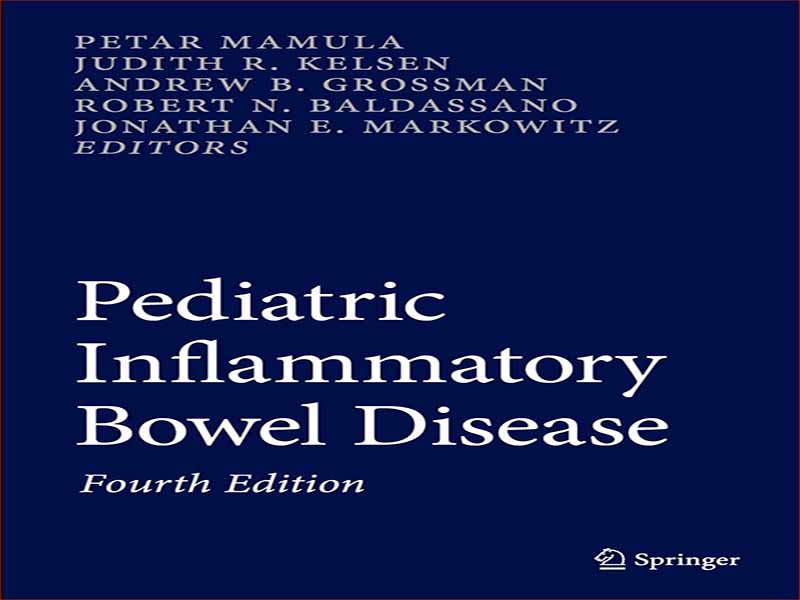- عنوان کتاب: Pediatric Inflammatory Bowel Disease
- نویسنده: Petar Mamula
- حوزه: روده
- سال انتشار: 2023
- تعداد صفحه: 847
- زبان اصلی: انگلیسی
- نوع فایل: pdf
- حجم فایل: 15.3 مگابایت
بیماری های التهابی روده اطفال (IBD) شایع ترین و مهم ترین اختلالات مزمن در گوارش کودکان است. شروع بیماری کرون و کولیت اولسراتیو در دو دهه اول زندگی تعدادی از چالشهای تشخیصی و درمانی را ارائه میکند که مختص بیماران اطفال است. اگرچه مطالعات موجود برای تشخیص اطفال در سه دهه گذشته به طور چشمگیری بهبود یافته است، اما پیشرفت در فناوری به تنهایی نمی تواند دلیل افزایش فراوانی IBD شناخته شده در اوایل دوران کودکی باشد. در حالی که درمان برای بیماران مسن تر با توسعه استراتژی های بیولوژیکی و مولکولی کوچک هیجان انگیز به طور چشمگیری بهبود یافته است، به ندرت مطالعات جامعی در مورد فارماکوکینتیک، ایمنی و اثربخشی هر یک از داروهای IBD در بیماران اطفال انجام شده است. تعدادی از داروهای عالی در آمادهسازیهای مایعی که کودکان میتوانند آنها را ببلعند در دسترس نیستند، و داروهای دیگر، مانند فرمولهای رهش زماندار، برای تحویل به دستگاه گوارش بزرگسالان ساخته شدهاند. مایه تاسف است که مراقبتی که ما از کودکان ارائه می کنیم اغلب برون یابی از آنچه در مورد بزرگسالان مبتلا به IBD شناخته شده و در دسترس است است. بیماران اطفال مبتلا به IBD با تعدادی چالش منحصر به فرد روبرو هستند. شروع بیماری قبل از بلوغ می تواند مخرب باشد. شکست رشد یک مشکل بخصوص دشوار با پیامدهای بالقوه دائمی است. بسیاری از تحقیقات ویژه کودکان بر نقش تغذیه درمانی برای درمان نارسایی رشد و القای بهبودی متمرکز شده است. استراتژیهایی مانند تجویز شبانه مکملها به روش بینی معده در بیشتر مراکز اطفال گسترده است و بهطور شگفتانگیزی حتی توسط جوانترین بیماران به خوبی تحمل میشود، بهویژه زمانی که ارزش درمان تغذیهای از قبل برای خانواده و کودک ارائه شود. تغذیه باید به شدت برای بیماران اطفال مورد حمایت قرار گیرد، زیرا ارزش درمانی زیادی دارد و تنها درمانی است که هیچ عارضه بالقوه جدی برای آن وجود ندارد. عواقب طولانی مدت درمان پزشکی و جراحی به ویژه برای بیماران کودکان نگران کننده است. در حالی که بسیاری از عوارض جانبی زیبایی برگشت پذیر هستند، آسیب روانی به یک نوجوان می تواند طاقت فرسا باشد. ما تازه شروع به درک و پرداختن به عواقب طولانی مدت درمان در سنین پایین کرده ایم. تجمع توده استخوانی و رشد خطی فرآیندهای مهمی هستند که وابسته به سن هستند و در اوایل نوجوانی به اوج می رسند. شکست درمان در این مرحله عواقب دائمی و احتمالاً ناتوان کننده خواهد داشت. با این حال، پیشرفتها در درمانهای بیولوژیکی و مولکولهای کوچک منجر به تغییر چشمگیری در تسلیحات درمانی شده است. در بزرگسالان، “هرم درمانی” از همه طرف تغییر کرده است، که منجر به بهبود کیفیت زندگی و کاهش مواجهه کلی با کورتیکواستروئیدها شده است، اما با مجموعه ای جدید از عوارض جانبی بالقوه درمان. در حالی که بیماران اطفال بدون شک از دادههای بزرگسالان که از استراتژیهای «بالا به پایین» پشتیبانی میکنند سود میبرند، دادهها در بزرگسالان لزوماً استراتژیهای بهینه را برای کودکان پیشبینی نمیکنند. اثرات درمان “تهاجمی” بیشتر به دلیل مثبت و منفی بودن آنها شناخته می شود و خطرات و فواید بدون شک در کودکان و نوجوانان متفاوت است. خواه وضعیت سیستم ایمنی نابالغ، تأثیر رشد سریع، یا حساسیت پس زمینه به بدخیمی های مختلف در سنین مختلف باشد، بروز مشکلات عمیق مانند لنفوم سلول T کبدی به همه پزشکان یادآوری می کند که ما ویژگی منحصر به فرد را درک نمی کنیم. جنبههایی از بیمار جوانتر که ممکن است باعث افزایش حساسیت شود. پیشرفت های علمی باورنکردنی بینش هیجان انگیزی را در مورد IBD با درمان های جدیدتر بعدی ایجاد کرده است و نسخه چهارم این کتاب را کاملاً تضمین می کند. در دهه های پس از کشف اولین ارتباط ژن IBD، 200 جایگاه دیگر شناسایی شده است و ویژگی ها و عملکردهای فردی این مکان ها به طور فزاینده ای درک می شود. این تنها آغاز هم افزایی است که می توان از ترکیب نتایج پروژه ژنوم انسانی و در دسترس بودن آرایه های گسترده ژنوم به دست آورد. افزایش تمرکز بر جنبههای منحصر به فرد و علل شروع خیلی زود IBD (VEO-IBD) منجر به ایجاد گروه هیجانانگیز و جدیدی از بیماریها شده است که احتمالاً تک ژنی هستند. فن آوری توالی یابی، از جمله پانل های هدفمند، توالی یابی کل اگزوم و کل ژنوم، زمینه را با شناسایی نقایص تک ژنی و اهداف درمانی جدید پیش برده است. این به یک رویکرد پزشکی دقیق برای کودکان مبتلا به VEO-IBD ترجمه شده است که منجر به بهبودی و در برخی موارد حتی درمان بیماری می شود. شناسایی نقایص تک ژنی همچنین منجر به پیشگیری از عواقب فاجعه بار بیماری مانند بدخیمی شده است، مانند مورد پیوند سلول های بنیادی آلوژن در کمبود IL10R.
Pediatric inflammatory bowel diseases (IBD) are the most common and most significant chronic disorders in pediatric gastroenterology. The onset of Crohn disease and ulcerative colitis in the first two decades of life presents a number of diagnostic and therapeutic challenges that are unique to pediatric patients. Although the studies available for pediatric diagnosis have improved dramatically in the past three decades, the improvement in technology alone cannot account for the increased frequency of IBD recognized in early childhood. While therapy for older patients has improved dramatically with the development of exciting biologic and small molecule strategies, rarely if ever have comprehensive studies of the pharmacokinetics, safety, and efficacy of any of the IBD medications been performed in pediatric patients. A number of excellent medications are not available in liquid preparations that can be swallowed by children, and others, such as timed-release formulations, are developed for delivery to an adult gastrointestinal tract. It is unfortunate that the care we provide to children is often an extrapolation of what is known about and available for adults with IBD. Pediatric patients with IBD face a number of unique challenges. The onset of disease before puberty can be devastating. Growth failure is a particularly difficult problem with potentially permanent consequences. Much of the pediatric-specific research has focused on the role of nutritional therapy to treat growth failure and induce remission. Strategies such as nocturnal nasogastric administration of supplements are widespread in most pediatric centers and are surprisingly well tolerated even by the youngest patients, particularly when the value of nutritional therapy is presented in advance to both the family and the child. Nutrition must be strongly advocated for pediatric patients, as it has great therapeutic value and it is the only therapy for which there are no serious potential complications. The long-term consequences of medical and surgical therapy are particularly troubling for pediatric patients. While most of the cosmetic side effects are reversible, the psychological trauma to an adolescent can be overwhelming. We are only beginning to understand and address the long-term consequences of therapy given at an early age. Bone mass accumulation and linear growth are critical processes that are age dependent, with peaks in early adolescence. Failure of therapy at this stage will have permanent and possibly debilitating consequences. However, the advances in biologic and small molecule therapies have resulted in a dramatic shift in the therapeutic armamentarium. In adults, the “therapeutic pyramid” has been turned on all of its sides, leading to improvement in quality of life and a decrease in overall corticosteroid exposure, but with a potential new set of adverse events from therapy. While pediatric patients undoubtedly benefit from the adult data supporting the “top-down” strategies, the data in adults does not necessarily predict the optimal strategies for children. The effects of more “aggressive” therapy are being recognized for their positives and negatives, and the risks and benefits are undoubtedly different in children and adolescents. Whether it is the state of the immature immune system, the effect of rapid growth, or the background susceptibility to different malignancies at different ages, the incidence of profound problems such as hepatosplenic T-cell lymphomas reminds all practitioners that we do not understand the unique aspects of the younger patient that may confer increased susceptibility. The incredible scientific advances have generated exciting insight into IBD with subsequent newer therapies and fully warrant a fourth edition of this book. In the decades since the first IBD gene association was discovered, another 200 loci have been identified, and the individual characteristics and functions of these sites are increasingly understood. This is only the beginning of the synergy that can be achieved from the combination of the human genome project results and the availability of genome-wide arrays. The increased focus on the unique aspects and causes of very early onset IBD (VEO-IBD) has led to an exciting and new group of diseases that are more likely to be monogenic. Sequencing technology, including targeted panels, whole exome and whole genome sequencing have moved the field forward with the identification of causative monogenic defects and new therapeutic targets. This has translated into a precision medicine approach for children with VEO-IBD, resulting in remission and in some cases even cure of the disease. Identification of monogenic defects has also led to the prevention of catastrophic sequelae of the disease, such as malignancy, as in the case of allogenic stem cell transplant in IL10R deficiency.
این کتاب را میتوانید بصورت رایگان از لینک زیر دانلود نمایید.
Download: Pediatric Inflammatory Bowel Disease




































نظرات کاربران